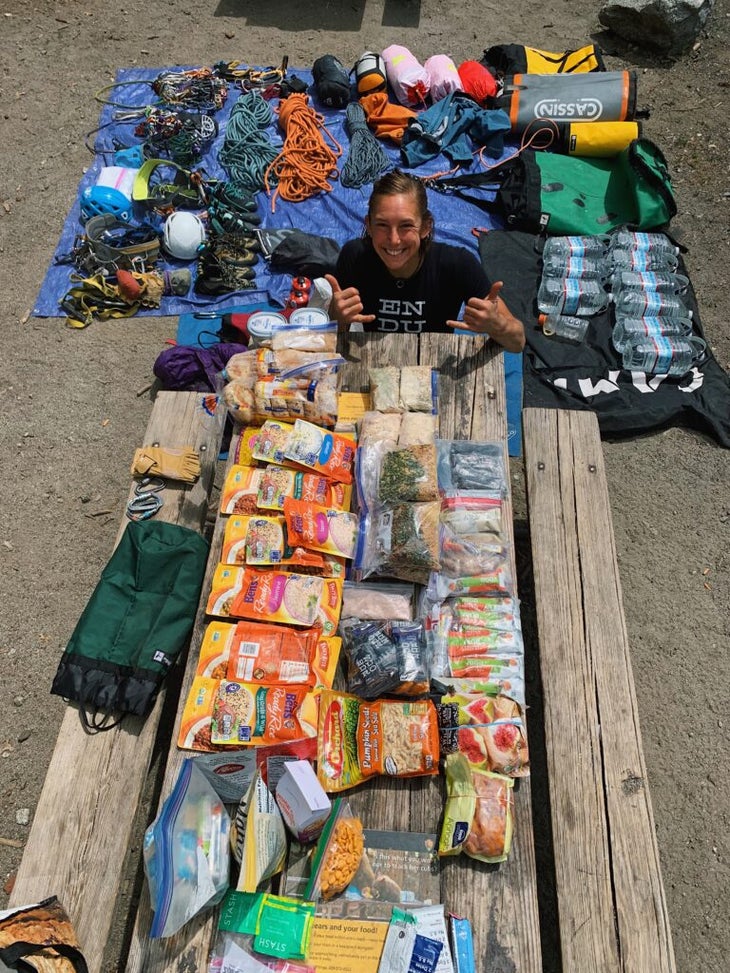
Pro tips and fuel ideas for any climber
The post 5 Climbing Nutrition Guidelines for Reaching Your Potential From Amity Warme appeared first on Climbing.
]]>
Chances are, you’ve seen Amity Warme giving it her all on a route this past year. But Warme isn’t just a rising talent in the climbing world who’s impossibly fun to watch—she’s also a registered dietitian who specializes in providing nutrition guidelines to climbers and other athletes to help them reach their full potential.
Whatever Warme is doing when it comes to nutrition and training is clearly working. This past season, she put down the Vortex Trilogy—a series of three, under-the-radar multipitch routes on sandstone just outside Sedona, AZ: Cult Leader (5.13d, 5 pitches), Cousin of Death (5.13d, (5 pitches), and Dickel’s Delight (5.13c, 6 pitches). “Only a couple other people have sent all three routes so it felt like a worthy challenge and was really special to see it through,” Warme says.
When it comes to her own nutrition, Warme does her best to follow her own advice. She eats a wide variety of nutrient-dense foods, avoids being too rigid or restrictive, and makes sure she’s fueling adequately for the demands she places on her body through climbing and training. Some of her go-to fuel includes Greek yogurt with berries for breakfast, pita bread or bagels for on-the-wall snacks, and dried fruit for quick energy between pitches.
Read on for the climbing nutrition guidelines Warme follows to try hard on the wall.

As a sports dietitian, I work with a wide range of climbers from beginner to elite, including boulderers, comp climbers, trad climbers, and everyone in between. Despite the array of individual ability levels and interests, nearly everyone who comes to me for nutrition coaching wants to maximize their performance and general health.
The following are five guidelines to follow when it comes to nutrition to make the most of your training and (hopefully) send your project.
1. Underfueling will hold you back
In gravitational sports like climbing—where you are moving your body against gravity to accomplish the goal—there is a tendency to adopt the mindset that lighter is always better. That can make teasing out the nuance between discipline and disorder feel complicated.
I get it. Gravity is real, so we can’t ignore that nutrition is one piece of the performance puzzle. But chronic underfueling prohibits you from reaching your potential. Problems arise when too much emphasis is placed on low body weight. That’s because neglecting the importance of food as fuel impacts optimal performance, training adaptations, growth and development, and long-term health.
Why underfueling in climbing is a problem
Put simply, your body requires a certain amount of energy (calories) from food each day in order to maintain basic physiologic functions. This is called your basal metabolic rate (BMR). Adding in activities of daily living and exercise significantly increases the energy your body uses.
After subtracting the energy used for exercise, the energy left for physiological functions is called your Energy Availability (EA). If there is not enough to cover your BMR, your body will be in a state of Low Energy Availability (LEA). LEA can lead to Relative Energy Deficiency in Sport (REDs), which leads to a wide array of detrimental health and performance issues. Chronic underfueling, whether intentional or not, puts many climbers at risk for REDs and its associated symptoms.

2. You can’t maximize your training without proper nutrition
Athletes often come to me when they start a new training program in an effort to get the most gains for their grind. Establishing a proper fueling strategy before, during, and after your training sessions is crucial. This is what enables your body to achieve the training adaptations you’re looking for by spending all those hours in the gym.
Training is an anabolic stimulus for your body—you are prompting your body to make strength gains and respond to training. We want to use nutrition to augment and “convert” that workload into adaptations that will benefit your climbing. So how do we do that? By making sure we are properly fueling the training window. The goal is to bookend your workout with energy from food in order to buffer the stress of training on your body.
How to optimize your training through nutrition
Put in place nutrition around your training window. I recommend this dietary strategy from Tom Herbert of Useful Coach:
- Before training: Around 45-60 minutes before training, consume ~25-30 grams of protein, and a minimum of 60 grams of carbohydrates.
- Aim for simple, easily digested carbs like rice, oats, fruit/dried fruit, a baked potato, cereals, a bagel, and pita bread. Experiment with what works best for you. Most athletes will better tolerate foods that are lower in fiber and fat that are easier to digest before hard exercise.
- During training: If your workout or training session is longer than an hour, take in at least 30 grams of easily digested carbohydrates per hour.
- For these easy-to-stomach carbs, turn to bananas, dates, pretzels, granola, bars, or sport chews/drinks.
- Immediately after training: Eat at least ~25-30 grams of protein, and at least 60 grams of carbohydrates.
- Aim for nutrient-dense whole foods such as an animal- or plant-based protein source, whole grains, and plenty of fruits and veggies.
- If you don’t have time or access to a full meal right after your session, it is still important to replenish your body as soon as possible after training. Keep convenient, no-prep options in your car so that you have no excuse to skimp on recovery.
3. Fueling at the crag doesn’t have to weigh you down
Athletes often voice the concern of not wanting to eat too much and subsequently feel full or “heavy” while giving burns on their project. But at the same time, they feel frustrated by only having enough energy for a couple of good efforts before fatigue hits. To mitigate these issues, it is helpful to strategize both the timing and types of food you bring to the crag.
Here are some of my strategies for crag-day nutrition:
- Before you leave for the crag, start the day with a nutritious, well-balanced breakfast that includes both a protein source and complex carbohydrates. Don’t forget to hydrate here as well.
- If your day involves a long approach, eat a snack after the hike, before you start climbing, or as you are warming up. To ease digestion, aim for something higher in carbs, and lower in fat and fiber. For me, that usually looks like oats with fruit and other toppings, banana or apple, or yogurt with berries
- As you’re working your project, try to eat a snack after each attempt, right after you get back to the ground. This gives your body time to digest while you are resting and belaying your partner. By the time it’s your turn again, your body will have had time to convert that snack into available energy for your next attempt on the project.

4. Don’t delay multi-pitch nutrition until you’re bonking
It can be easy to forget to fuel appropriately on the wall when you’re always busy climbing, belaying, or dealing with gear and rope management. The goal is to stay ahead of your hunger and thirst on longer multi-pitch routes and on big walls. If you wait to eat and drink until you’re already famished, it will be much harder to catch back up.
This is the multi-pitch nutrition strategy I use to stay on top of my fueling:
- Fuel and hydrate well the night before and in the morning before starting your adventure.
- Pack foods that:
- You know you like and will be excited to eat
- Are not difficult or messy to eat
- You know work well for you and your digestion
- Keep snacks easily accessible by storing them at the top of your pack, in your pockets, or in an Avant Multipitch Snack Pack. This way you can quickly grab a bite while your partner is following the pitch or while you are racking up for the next pitch.

5. Your training weight doesn’t need to be the same as your performance weight
I see many climbers fall into the trap of striving to maintain their lightest possible weight year-round, for years on end. With training, we can’t expect to maintain peak strength, power, and fitness for years at a time. Likewise, with nutrition, it is not sustainable to be at “fighting weight” for an extended time.
Again, I understand that gravity is real. In theory, it makes sense that there would always be a positive correlation between losing weight and sending your project. But in order for weight loss to be used as a performance benefit, there have to be fluctuations. If you hold steady at your lowest possible weight year round, then you have nowhere to go and no room to use slight, strategic weight loss as a performance benefit when peak season on your project rolls around.
Certainly, not everyone needs to get this fine-tuned with their nutrition. But if you are truly seeking your limit, it can be worth exploring the idea of a training weight and performance weight. I would strongly recommend working with a sports dietitian to navigate the nuance of this.
How to strategically use “performance weight” to improve your climbing:
- Throughout the majority of the year, maintain a slightly heavier body weight and focus on optimally fueling your climbing and training. This allows your body and mind to make desired training adaptations, recover well between sessions, decrease risk of injury and illness, and generally thrive at a higher level of function.
- When the time comes for peak performance, you can strategically and conservatively aim to reduce body weight by a marginal amount (e.g., 2% of your total body weight). You can do this by choosing times of your day and week when you are less physically active to introduce a small calorie deficit, while keeping training and climbing nutrition in place as discussed above.
- The key is that this minor weight loss is acute, planned, and ideally managed with the guidance of a nutrition professional. Weight loss should occur before the performance period and focus should return to optimal fueling for energy and recovery during the performance phase. It is only reasonable to hit this performance weight up to two times per year and maintain it for a few weeks at a time, before needing to start the cycle again.
Amity Warme is a professional climber and registered dietitian. For further questions, get in touch with her at amitywarme.com.
The post 5 Climbing Nutrition Guidelines for Reaching Your Potential From Amity Warme appeared first on Climbing.
]]>